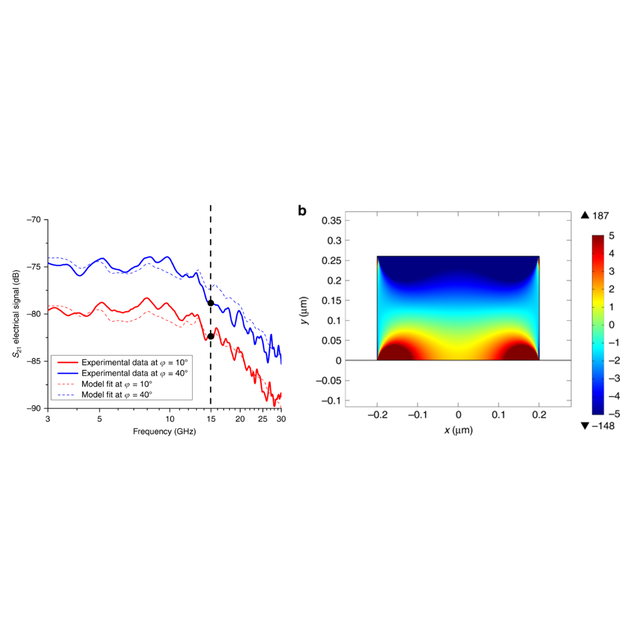Researchers from C2N demonstrated a high-speed Pockels effect in strained silicon waveguides, clearing the doubts raised over the last decade on its existence.
The explosion of data demand imposed new requirements in terms of data transmission rate and power consumption that are more and more difficult to meet without greatly increasing the power consumption in data centres and hot spots of communication networks. In this context, silicon photonics is considered as the most adapted solution to address these complex issues by replacing power hungry on-chip metallic interconnect by silicon-based photonics links. One key step consists in the conversion of data carried by an electric signal to an optical signal by means of an electro-optic modulator. A lot of efforts were put into the conception of high-speed and low power consumption modulators while reducing fabrication costs and complexities by exploiting microelectronics-based materials including silicon and germanium.
An ultrafast electro-optic effect used in most fibre communication circuits such as lithium niobate modulators is the Pockel effect, relying on the second order non-linear susceptibility. However, silicon being a centrosymmetric material, it cannot exhibit Pockels. Nonetheless, this limitation is relaxed by applying deformations to the silicon lattice by means of stress in order to break its inversion symmetry. Numerous theoretical and experimental studies were recently reported to demonstrate and quantify the Pockels effect in strained silicon. But, the semiconductor nature of silicon tremendously complicates the analysis of the Pockels effect, whose existence was questioned in strained silicon and became a source of controversy. Indeed, free carriers in silicon waveguides and at the interfaces induce a strong electro-optical signal, thereby screening the signature of the Pockels effect.
For a few years, a team at C2N has been studying the theoretical aspects of the Pockels effect in strained silicon. In this work, the researchers experimentally demonstrated the clear presence of a Pockels-based electro-optic modulation signal at frequencies higher than 20GHz to stem free carriers effect. In addition, the researchers developed a multiphysics model to describe the experimental results and extracted the second-order nonlinear electric susceptibility tensor quantifying, among others, the ability for a material to give rise to the Pockels effect. Particularly, the spatial distribution of all optical nonlinear components in strained silicon waveguides has been determined for the first time. Dependences on both the propagation direction of light within the silicon lattice and the level of stress applied to silicon were also observed and analysed. This work is published in Communications Physics (Nature Press).
The results presented in this article pave the way for the optimization of efficient electro-optic silicon modulators based on Pockels effect.
*This work has been performed in the framework of ERC Popstar project dedicated on the development of strained silicon photonics.
Reference:
Fast linear electro-optic effect in a centrosymmetric semiconductor,
M. Berciano, G. Marcaud, P. Damas, X. Le Roux, P. Crozat, C. Alonso Ramos, D. Pérez Galacho, D. Benedikovic, D. Marris-Morini, E. Cassan and L. Vivien
Communications Physics 1: 64 (2018), Nature Press
DOI: https://doi.org/10.1038/s42005-018-0064-x
- Centre de Nanosciences et de Nanotechnologies – C2N (CNRS / Université Paris-Sud- Université Paris-Saclay)
Contact:
- Mathias Berciano, PhD Student at C2N
- Laurent Vivien, CNRS Senior Researcher
Figure: Left: Comparison between theoretical and experimental electro-optic responses, between 3 GHz and 30 GHz for different light propagation directions. A good agreement between experimental data and the theoretical model was achieved. Right: Spatial distribution, in a strained silicon waveguide, of the main component of the second-order nonlinear electric susceptibility tensor responsible for the measured Pockels effect. © C2N/M. Berciano









